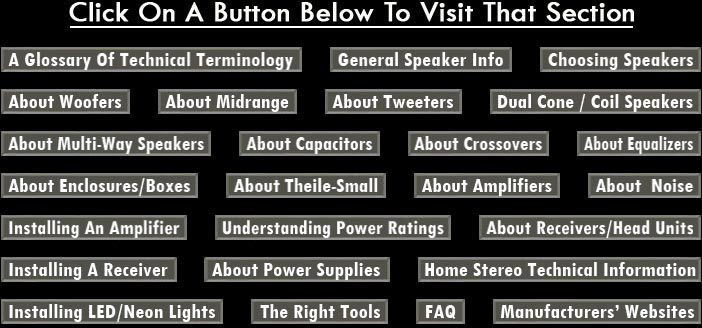


Home Stereo Frequently Asked Questions
Q. What size wire do I need to use?
A. We suggest using 16 to 18 gauge wire (AWG) for all Boston Acoustics speakers. For runs longer than 75 feet, a lower gauge (thicker wire) may be needed to avoid any loss of signal.
Q. What is the difference between Dolby Pro Logic and Dolby Digital?
A. Dolby Pro Logic is a 4-channel surround system that provides left and right main speaker channels, a center channel to keep dialogue centered on the TV regardless of viewer location, and a mono surround channel (This mono signal is usually spilt between two surround speakers). Dolby Digital is a 5.1 channel surround system that provides left and right main speaker channels, a center channel, and discrete, full-range left and right surround channels. The .1 in 5.1 is the Low Frequency Effects (LFE) channel. It sends additional bass information to the subwoofer-usually involving dramatic sound effects like explosions.
Q. What is a diffuse field surround?
A. Diffuse field (Sometimes called "dipole surrounds duplicate the effect produced by multiple surround speakers found in movie theaters. They fire sound forward and back, but not directly at your ears. Sound bounces off all of the room's surfaces before reaching your ears, creating a diffuse sound field that feels like its all around you. The result: your ears will not be able localize where the sound is coming from, and will be fooled into believing they are in a new environment entirely. Conventional speakers often fire sound right at your ears, and the effect is lost.
Q. What is "timbre matching"?
A. This means that all of the speakers in a home theater system have the same sound characteristics or voicing. This allows for a smooth, convincing transition between left, center, right, and surround channels.
Q. Where should I place my subwoofer?
A. Subwoofers sound best if placed near a wall or corner of the room. The subwoofer will use the surface area on the wall or walls to reinforce the bass and increase its overall output. This is referred to as "loading". Bass frequencies are omni-directional (A fancy way for saying they radiate in all directions, not in a single direction like high frequencies) so it is not necessary to place the sub in the front of the room.
Q. When should I use the phase switch on my subwoofer?
A. The phase switch is used when the bass is weak at your listening area. Some rooms have what is known as a " bass null" or spot where there is little or no bass. If this null happens to be right at your listening area then the switch can be used to help reverse this effect.
Q. What is the proper setting for the crossover on my powered subwoofer?
A. If you are using Digital 5.1 home theater electronics, the best results will be obtained if you bypass the subwooferas built-in crossover altogether. Receivers with 5.1 channel processing perform their own bass management functionsathat is, they do the acrossing overa themselves. In this case, set the receiveras set-up menu to asubwooferayesa and connect your subwoofer through its abypass crossovera inputs.
If you are not using Digital 5.1 electronics (you have an older Dolby Pro Logic receiver or a regular two-channel system, for example), or have an older subwoofer that does not have abypass crossovera inputs, then the best way to adjust the variable crossover is to experiment with different settings. A good place to start is slightly above he -3dB point of your main left and right speakers. If they're rated down to 70 Hz, for example, start around 80 Hz. Use the subwoofer's volume control to smoothly blend its output with the rest of your system and to adjust for personal taste.
Q. Can I place my subwoofer inside a cavity in my entertainment center?
A. Yes, you can place the subwoofer in the bottom of an entertainment center provided you keep at least 3a clearance all around the subwoofer cabinet for adequate ventilation and cooling and to allow the driver and woofer ports to abreathea properly for best response. With solid doors, do not obstruct the front of the subwoofer. Keep in mind that the subwoofer will excite certain resonances in the room (It'll make objects rattle and buzz), which may be undesirable. If you can't obtain satisfactory results in the entertainment center, place the subwoofer outside the wall unit, near the wall and corner.
Q. What mode do I set the center channel to?
A. The center mode on the surround processor or receiver should be set to normal. You should only use the "Wide" mode if your center channel is a large, full-range speaker. In the "Normal" mode, the center channel's bass frequencies are directed to the main left and right channels and thus to your subwoofer, maximizing your system's bass output.
Q. How close should the main speakers be apart from one another?
A. Ideally speakers should placed approximately 6-12 feet apart. If you place speakers more than 12 feet apart, place them at an angle pointing in toward the room's listening area, so you will not lose the stereo effect. If placement is too close, the sound will not have a three-dimensional feeling.
Q. Do the surrounds have to be the same distance apart as the fronts?
A. No. The surround sound speakers can be farther apart than the main speakers. This is common and will not affect the spatial or ambient qualities of the rear channel information.
Q. How far can the center channel be above the main speakers?
A. The center channel should be situated on top of the TV. If the height differential between the main speakers and the center channel is more than 18", angle the center channel so it is firing downward at the listening position.
Q. Should I use diffuse-field or direct-radiator surround speakers?
A. Choosing a diffuse-field surround or conventional direct-radiator speaker is a personal choice. The diffuse-field surrounds will envelop the listener in non-localizable ambient information providing a greater sense of space, whereas the forward firing speaker will offer better discrete left and right channel information.














